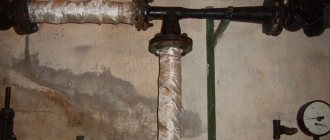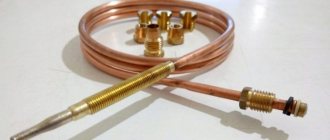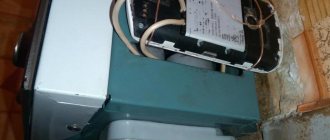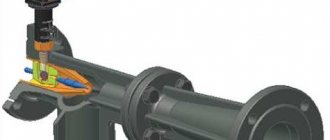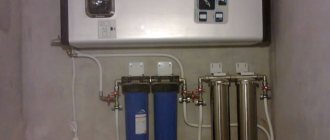Like any other mechanism, the water block has wear parts in its design. When they become unusable, the operation of the heater deteriorates or stops altogether. Common situation?
If a malfunction occurs, a home craftsman is quite capable of repairing the water unit of a geyser on his own by disassembling the gearbox and replacing used consumables. To begin with, we suggest you figure out how to disassemble and repair the water unit of an instantaneous water heater yourself. The information will also be useful when performing preventive examinations. We will provide the presented material with thematic photos and video materials.
Design and types of water block
The material used to make the water reducer varies and is therefore divided into several types:
- Brass. Alloy of copper and zinc.
- Plastic. The practical device is not subject to corrosion.
- Polyamide. Reliable device with fiberglass composition.
The column regulator or “frog”, as the block is also called, has protective functions. It serves to automatically turn on the device when water is supplied. It also protects against overheating when pressure in the line decreases.
- Base and cover with bolts.
- Rubber membrane with a disc on the rod.
- Flow device.
- Temperature switch.
- Flow sensor.
- Venturi tube.
- Filtering device for hot water.
The water pressure regulator cover can be held together with steel screws or plugs. Since the parts do not come into contact with water, there is no risk of corrosion. By unscrewing the screws, you will remove the cover behind which the membrane is located. The device is quite simple.
When you turn on the water, pressure is created on the membrane. It pushes out the rod, which operates the gas valve. Fuel is supplied to the burner and heating begins. When the mixer closes, the pressure drops - the parts return to their previous position.
An important part of the gas-water unit is the Venturi nozzle. What is it for? For example, in technology the tube is at the bottom. The location in the “Oasis” and “Astra” columns may differ. The part serves to reduce the pressure of the working medium. This is how the gas supply is adjusted.
When you close the tap, the tube equalizes the indicators, causing the membrane fitting to return to its place. After this, the device turns off.
The water part is also susceptible to breakdowns, so we will list the main faults and ways to repair them yourself.
Malfunctions
Qualified experts say that in 8 out of 10 cases of geyser breakdowns, the problem lies in the water unit. As a rule, this is contamination or deformation of the membrane in the assembly. Namely, the deposition of various clogs and salts occurs, as well as the formation of cracks in the housing, etc.
You should know that a damaged node cannot perform its functions fully. If the membrane is damaged, it cannot stretch enough to allow gas to pass through.
There are models of geysers whose membrane needs to be changed regularly. According to reviews, this is a device from the manufacturer Neva. In order to prevent breakdowns, from time to time you need to disassemble the gearbox in order to clean it. Then you can notice the deformation of the membrane in time. Filters in the water unit often become clogged.
The wear of the gearbox is explained by frequent switching on/off; this greatly affects the membrane in the unit, seals, etc. When the seal wears out, water begins to leak out of the gearbox.
We can conclude that the reducer for a gas water heater is an important part that needs to be maintained, which means it must be in such a position that there is constant access to it. Such maintenance of the gas water heater or, if necessary, repairs can be carried out independently, since these manipulations are not complicated. To replace or clean the gearbox you do not need to have special skills.
Rice. 4 Water unit for the column, the body of which is secured with 8 bolts
Typical unit problems
Most often, the unit fails due to poor quality water. Potassium and magnesium impurities settle and clog device parts. Pressure drops in pipes also have an effect. It has been proven that 80% of gas heater failures occur due to failure of the water-gas unit.
Study the main signs and causes of breakdowns.
The water pressure is normal, but the burner does not light
- Check the membrane. The rubber element quickly wears out, breaks, and leaks. It is better to install a silicone membrane instead of the old element.
- The rod is stuck and won't budge. Perhaps he got used to it. Lubricate this area and the oil seal with grease to restore operation.
The cold flow is quite strong, but the hot flow is weak
- The mesh filter is clogged with small debris and rust. Remove and clean the part.
- The nozzle at the entrance to the unit is clogged. Cleaning is also carried out.
When opening the mixer, the column does not start immediately
- The retarder ball channel is clogged. The elements are disassembled and cleaned. The ball is located in the unit cover.
- The retarder ball is not adjusted correctly. You need to tighten the adjusting screw.
After closing the taps, the device does not stop working
- The ball is jammed or its channel is clogged.
The equipment does not operate at full capacity and may go out during operation.
- The membrane was damaged. The faulty element needs to be replaced.
If you discover a malfunction and decide to do the repair yourself, read below on how to remove the gearbox.
Why does the burner burn weakly or turn off?
- The burner does not turn on - reasons:
- insufficient water pressure;
lack of spark;
- improper operation of the ignition wick;
- bad traction.
- Weak flame on the burner - reasons:
- problems with the water unit (frog), the membrane has failed or the rod needs maintenance;
insufficient water pressure in the pipeline;
- The burner of the gas water heater burns poorly and due to the nozzles being clogged with soot, owners of water heaters operating on liquefied gas especially often face this problem.
- The main burner does not work - the igniter is triggered or the wick is working. The reason lies:
- In a littered chimney duct, lack of air circulation leads to the accumulation of flue gases. Problems with draft affect the operation of the burner; there is no flame or burns unevenly.
- Problems with the water regulator - inside the block there is a rubber membrane and a rod connected to the valve. When water enters, pressure is applied to the metal rod, which turns on the gas supply. If the gasket ruptures or the rod is corroded, gas does not enter the burner and the flame does not ignite.
- In geysers with a modulating burner, the absence of a flame indicates a failure of the servo drive or valve. In battery-powered water heaters, failure is often due to the fact that it is necessary to replace dead power sources.
- The burner does not turn off - the flame continues to burn after the DHW tap has been closed. The decay period is several seconds or more. The reason is that the membrane installed in the water regulator has become hardened by hard water. The malfunction may be related to the stem. In this case, either rust has appeared on the rod, or the spring that brings it to its original position after turning off the water has weakened.
In all of these cases there is no flame. If the column turns on, it is only temporarily and after repeated opening of the DHW tap.
If the flame burns unevenly, has a red-white hue, protrudes beyond the heat exchanger, and there is a stable water pressure, it is necessary to clean the outer part of the radiator. In automatic gas water heaters, failure to modulate the burner flame indicates a malfunction of the programmer in the control unit.
Dismantling the water unit
To carry out repairs, the unit must be removed from its seat. This is only possible together with the dismantling of the gas unit.
- Turn off the gas supply valve.
- Disconnect the cold water hose.
- Using a wrench, disconnect the assembly from the pipe.
- Disconnect the wiring from the gas valve and microswitch.
- Use a screwdriver to unscrew the flange bolts.
- Remove the water-gas block.
Now you need to disassemble it and replace the broken parts:
- To disconnect the gas part from the water part, unscrew the two screws. One is on top, the other is on bottom. You can not unscrew it completely, but slightly loosen the fastening. It happens that the bolts stick. Spray these areas with WD-40.
- Separate the blocks.
- Now unscrew the frog screws on top.
- The body will split into two parts and the diaphragm will become accessible.
- Remove the rubber part (if it is faulty, prepare a new one).
- Pull out the disc with the stem. Behind them is a spring.
- Remove the spring and check the seal located behind it. It requires periodic cleaning and lubrication.
- Install new parts and reassemble the unit in reverse order. The oil seal can be lubricated before installation.
- When tightening the frog bolts, lubricate them with graphite lubricant.
To avoid running the column into a faulty state, check its components every six months and clean them of scale and dirt.
Source
Features of membrane replacement in new models
The water units of modern speakers work on the same principle. The main differences between new designs of instantaneous water heaters are the saturation of control units, monitoring units, touch screens, and wires.
Some fasteners have changed. For example, now screws are tightened and unscrewed with special screwdrivers with an asterisk. Innovations affected both the shape of the frogs and their connection to the gas block.
On devices Amina, Selena, Milla, Ross (popularly - Chinese), it is better to entrust the replacement of the frog gasket to specialists, since the gas part needs to be dismantled along with the water part
On branded speakers Bosch and Junkers, the water unit is located at the bottom right. To remove it, you need to disconnect the terminal of the draft sensor located in front of the control unit.
Having turned off the water supply to the column and opened the hot water tap, use a screwdriver to remove the bracket that holds the pipe running from the heat exchanger to the heat exchanger. Pulling the pipe slightly to the right from the water unit, wait until the water from the system pours out through the tap, after which the pipe is removed completely. After this, use a wrench to unscrew the nut securing the water block to the water supply.
Brackets are a new type of fastening of structural elements of the water block of Bosch and Jurkers speakers; they are pryed off and released using a screwdriver
Unscrew the VU fastening screws with a Phillips screwdriver. They are located at the bottom of the structure. There is no need to unscrew them completely. After this, the water block is at the owner’s disposal. It can be inspected, cleaned, and consumable parts replaced (the coarse filter mesh can be cleaned without removing the VU).
There are much more consumable parts in such a frog than in the gearbox of the Neva Group of Companies. Firstly, the water block itself is made of plastic, the mounting screws are screwed directly into the plastic (no brass inserts). The connection is not designed for many cycles of assembly and disassembly. If there is a leak along the VU rod, the cover will need to be replaced completely (maximum service life is 2-3 years).
Secondly, in addition to the functions described above, it additionally regulates the amount of water flowing through the column, so a stable liquid temperature is maintained at the outlet of the hot water tap.
In a Bosch water heater, the silicone membrane is a convex cap of complex design that cannot be cut from flat rubber. Just buy, and, moreover, your own one
Design and principle of operation of a gas water heater
Here you will learn:
Before we begin to consider the design of the column, it is worth noting that modern devices for DHW needs come in two types:
- with an open combustion chamber;
- turbocharged, with a closed combustion chamber.
These types of heaters have design differences, which we will outline during the study. So, a traditional water heater is a unit suspended from the wall, to which pipes for gas and water are connected. The figure below shows the speaker structure:
1 – sensor for the presence of draft in the chimney; 2 – temperature sensor; 3 – burner; 4 – temperature regulator; 5 – gas connection pipe; 6 – chimney connection pipe; 7 – diffuser; 8 – heat exchanger; 9 – gas valve; 10 – flow regulator; 11 – water connection pipes.
Since it is difficult to show all the details and elements in the figure, we list the most important of them that are not included in the list:
- water node;
- ignition system;
- flame presence sensor;
- igniter;
- safety relief valve.
A turbocharged gas water heater has a closed combustion chamber design; air is pumped into it by a fan. As a rule, in such units a burner with smooth flame control (modulation) is installed. The device is controlled by an electronic unit that receives signals from sensors. Below is a block diagram of a gas water heater with a closed combustion chamber:
Reasons for diaphragm failure
Membranes are consumables with a service life of 5-8 years (on average). The elasticity of the material decreases over time. As a result of the action of alternating stresses, fatigue occurs over time in each material subject to bending—the formation and accumulation of damage. If the membranes operate in an intensive mode, when the gas water heater is used frequently and a lot, fatigue occurs earlier. Microcracks appear in the body of the diaphragm, then breakthroughs form.
The scale that forms inside the frog also contributes to rapid wear of the diaphragm. Another reason is the use of clandestinely produced diaphragms. Often such products are made from low-quality rubber.
Therefore, information on how to properly replace the membrane in a household geyser if it fails will come in handy. With such knowledge, you can repair the water unit on your own, without involving specialists.
This is what the water reducer looks like after removal. As a result of grooving the oil seal, scale formed on the rod and its nut, which is removed during the process of replacing the diaphragm
Principle of operation
To understand the principle of operation of a geyser, you must first consider what security system it is equipped with. When the unit is in the off state, the control unit (16) does not receive electricity, since the circuit is broken in the microswitch (15). The switch plate is pressed by the pusher, and while this happens, it is in the off state.
The solenoid valve (19) is also closed and cuts off the gas supply from the inlet pipe, since it is not receiving power. But this is not the only place that shuts off the gas - it is also shut off using a spring valve, which is located in the gas module (35). The inoperative state of the valve is characterized by pressing the disc gasket against the seat, which ensures complete shutoff of the supply of the combustible mixture to the manifold.
The water section consists of a two-chamber module (36), colloquially called a “frog”, with an elastic rubber membrane. Using a special channel, the “frog” cameras can communicate. When the water supply is turned off, the pressure in the chambers is equalized and the membrane is in an equilibrium position.
The principle of operation of a gas water heater
Water is supplied to the heat exchanger through the bottom of the chamber. At the top there is a rod with a plate made of plastic, which is adjacent to the membrane. The rod comes out through a hole in the middle, towards the gas block. Opposite this rod, in the gas module, there is the same one, but connected to a spring valve, to which is attached a pusher coming from the switch.
What happens when the water starts
How does a gas water heater work if you dig up water? When you open a water tap at the point of consumption (water intake), the following happens.
- When a liquid flow passes through the “frog”, a vacuum is created in its chamber. The rubber membrane, under the influence of increased pressure, bends and pushes the plate out. The latter transmits the pushing movement to the rod. The water module rod pushes the opposite gas module rod (37).
- Next, the pusher, which is connected to the rod, no longer holds the switch plate, and it is released. In this case, the switch closes the circuit, and power begins to flow into the electronic control module from the battery section.
- The movement of the rod also forces the spring of the mechanical valve to depress, as a result of which the plate moves away from the seat, and the gas supply channel to the manifold becomes open.
- The solenoid valve, receiving power from the batteries, opens and does not interfere with the passage of gas through the spring valve towards the manifold.
- Meanwhile, the control unit generates and sends an electrical impulse to the spark plug (23) to create a spark discharge that can ignite the flame. When all components operate normally, the burner lights up.
Analysis of the most common installation errors
The most common mistake is installing a geyser in the bathroom. As a rule, this room does not have a window. It is especially dangerous to install speakers without a chimney. There are models of water heaters in which carbon monoxide exits through openings, and is removed from the room through a ventilation hole in the wall.
The second most common mistake is the desire to hide the device so that it does not visually stand out from the interior. Often a geyser is installed in a cabinet. This leads to disruption of the proper functioning of the gas water heater.
Even if a distance of 10 cm is maintained from the cabinet walls and there is no bottom bottom, the air flow will still be insufficient to cool the device. It will take longer to cool down, which will significantly shorten its service life.
The third mistake that often occurs is a mixed-up connection of the gas pipe in the column. This leads to water entering the gas pipeline. The liquid gets there through the gas column and then moves down through the pipes. This is how water enters the gas equipment of the neighbors below, completely disabling it.
Liquid removal is carried out by gas services. Once a source is discovered in the owner’s apartment, the gas will be turned off and a fine will be issued. This is what a gas shutoff order looks like
It is impossible to prevent GorGaz workers from performing a shutdown. In case of refusal, the police will be called, as people's lives are at risk.
Main characteristics of the speakers
Now let's talk about the practical aspects of using the speaker. One of the main characteristics is performance. It directly correlates with power, which is indicated in kW and shows the volume of water heated per minute by 25 °C.
The characteristics are usually indicated in the device passport. A regular water heater heats 10-20 liters of water per minute at 25 °C, although this value can vary significantly.
Another characteristic of modern speakers is power modulation. It shows how the power of the column can change depending on the flow of water and is measured as a percentage of the initial power.
For modulation, the columns are equipped with special fittings with a membrane, which changes the gas supply to the burner depending on the flow. Modulation in the range of 40-100% of the device power is considered normal.
The diagram shows the modulating valve and the principle of its operation, which is similar to the operation of a water unit and its membrane
Security sensors
A geyser can be dangerous, because it is connected simultaneously to water and gas mains, each of which individually can pose a threat.
If there are problems with the gas or water supply, safety sensors turn off the operation of the column, and special valves will shut off the water or gas supply.
Typically, geysers can withstand voltages of up to 10-12 bar, which is 20-50 times higher than normal pressure in pipes. Such sharp jumps are possible with so-called hydraulic shocks.
But if the pressure is lower than 0.1-0.2 bar, then the column will not be able to work. You need to carefully study the instructions and specifications before purchasing to understand whether the dispenser is optimized for low water pressure in pipes in the CIS countries and whether it will work properly. And vice versa - will it withstand sudden changes in pressure, which, alas, is also not uncommon in our conditions.
Required water pressure
The minimum pressure required to turn on the selected column is indicated in the equipment documentation
Paying attention to this parameter is especially important when installing a heater in old houses built in the 60-70s, since the pressure in their pipes is often insufficient for the heater to operate. If the manufacturer states that the minimum requirement is a pressure of more than 0.15 bar, then in an old building there may be problems with the functioning of this column
Another point is the ability of the column to withstand the hydraulic shock that periodically appears during water supply. This is the name for a short-term increase in pressure in pipes, which can cause leaks and damage to connections. With a value in the range of 11-12 bar, the column is able to withstand such changes.
Turning on the device
The first step is to install the batteries. To do this, open the battery compartment and install them, observing the polarity. Then you need to open the cold water and gas valves. Open the hot liquid tap on the nearest faucet.
At the moment when the liquid flows through the water unit, a spark ignition occurs and, thanks to this, the burner ignites. If it is turned on for the first time or after a long period of inactivity, air may accumulate in the gas line; in order to remove it, you will need to open the mixer several times, hold it for a minute, and then close it.
If the burner ignites, you need to turn the water pressure adjustment lever (located on the right) to the right, this will make it possible to turn on the Vektor JSD 20 device when the liquid pressure in the system has decreased.
Sources of danger
There are, in fact, only two of them.
The fact is that independent work related to opening the gas pipeline will inevitably lead to a gas leak.
- At a certain concentration of natural gas or propane-butane mixture in the air, it will become unbreathable.
- Long before this, the gas-air mixture will become explosive. The slightest spark when turning on an electrical appliance, triggering any relay (for example, a convector thermostat) or clicking a light switch will lead to exactly the consequences that we tried to warn the reader against in the first section of the article.
The rules that will help avoid negative consequences are quite obvious.
- All work is carried out with windows wide open throughout the entire apartment or house. Yes, yes, regardless of the time of year. Don’t be afraid that your favorite cactus will freeze: if everything goes well, forced ventilation will last no more than 10 minutes.
- The room must be completely de-energized. What the instructions relate to is, I think, clear from the previous explanation. Take it seriously: as already mentioned, the cost of a mistake can be the highest.
Let's get started
Tools
What should you prepare before opening a gas pipeline?
- We have already mentioned a pair of gas keys. Precisely a pair - because in most apartments of the old building, the supply to the stove is made of rigid pipes; To unscrew the locknut and coupling, you need to hold the drive in a stationary position, not allowing it to turn the valve.
- To seal gas threads, FUM tape or synthetic thread with Tangit Unilok sealant can be used. Linen with paint is also suitable, but the paint takes a relatively long time to apply to the threads and winding, and in our case, seconds will count.
- When repairing a tap, a special graphite lubricant for gas taps or regular grease can be used. The graphite base is more practical: it retains its properties longer.
- In addition, when repairing the valve, you will need a 1/2-inch female plug and a flathead screwdriver.
Audit
So, what to do if the gas tap smells like gas and replacing it is not in your plans?
- We close the valve by turning its handle perpendicular to the pipe.
- We use one of the gas keys to fix the outlet after the valve and then hold it in a stationary position.
- Using the second wrench, we tighten the locknut and coupling onto the long thread of the drive.
- We partially unscrew the valve with a key until it starts to rotate by hand.
- We completely unscrew the valve and immediately attach a plug to the thread. Do not be afraid that excess pressure will interfere with you: it is only 3 - 5% higher than atmospheric pressure.
- We wind the thread under the plug and tighten it by hand until the end.
- We unscrew the valve from the surge.
- We unscrew the plug with a groove for a screwdriver on the back side of the valve and remove the spring hidden under it; then we push the conical plug out of the body.
- We clean the body and plug from the remnants of the old lubricant and apply a thick layer of new one.
- Reassemble the valve in reverse order.
- We put it in place of the plug, not forgetting to replace the thread winding.
- We screw in the drive and, having re-winded the threads, we drive the coupling and locknut into the working position.
Replacement
What to do if the gas tap in the kitchen is leaking and you want to replace it with a new one?
If the new valve is the same length as the old one, the actions are completely similar to those described above - with the difference that manipulations with the plug are, for obvious reasons, made unnecessary.
How to change a gas tap in an apartment if its length does not match the length of the old one?
- The drive with the coupling and locknut is thrown out.
- The short thread after the drive is equipped with a short extension with internal and external threads. This will allow the union nut to press the gasket against the smooth, wide edge of the extension rather than against the jagged end of the pipe.
A special case
How to change the tap on a gas cylinder if it cannot be opened with a regular key? Heat the valve with a hair dryer - and its expansion will make the force required to unscrew it quite feasible.
Ignition of an old gas water heater
Devices with manual ignition are considered obsolete. Old-style devices provide for constant burning of the wick and manual shutdown. Ignition of an old gas water heater is carried out using a lit match or piezo ignition.
Although structurally they differ little from modern speakers, they have certain features related to heating:
- In order for the flame to burn stably, the room with the column must have good ventilation and regular air flow;
- Due to the lack of automation, you need to check the presence of traction yourself;
- There is a way to check for gas leaks in old dispensers: you need to lubricate the gas valve connections with soap (the appearance of bubbles means a leak).
Areas of responsibility
The first and main thing that the reader should pay attention to is that the inlet valve in the apartment falls under the responsibility of GorGaz or a similar organization operating in the area where you live. Both the repair and replacement of valves, and their periodic inspection, and the connection of gas equipment (stoves, boilers, convectors, hobs) should be carried out by mechanics of this organization
- you have quite a lot of experience in locksmith work; in particular, you have had to change valves and valves under pressure;
- you know where the power is cut off in your apartment, and you have access to the switchboard and the machines in it;
- the gas pipe in front of your valve has no visible signs of corrosion;
- at your disposal are plumbing tools (at least two gas wrenches No. 1 and/or No. 2), sealing material for threads and grease or graphite lubricant -
the following text will help you replace or repair the gas stove tap yourself.
Recommendations for maintenance and repair
All elements of the column structure are subject to destruction due to various factors. Any gas equipment requires regular maintenance. If defects are identified during maintenance work, they must be eliminated as quickly as possible. Of course, some repair work should be entrusted to a professional, but some can be done independently.
Dismantling and adjusting the gearbox
You must first turn off the fuel and water supplies. Only after this can you begin to carry out preventive or repair work. To remove the gearbox, you need to perform several steps:
- Water is drained from the heat exchanger;
- using an adjustable wrench, the gas and water pipelines are disconnected from the column;
- If no mistakes were made at the previous stages, the gearbox can be easily dismantled.
Depending on the model of the unit, changes may be made to its design. To avoid problems when dismantling the water reducer, you must first disconnect all pipes and parts that make the work difficult. The housing should be easy to remove; no physical effort is required.
To adjust the gearbox, you must use special bolts located on the back side of the unit. Most often, the unit is already prepared for operation at the factory and does not require additional configuration. It is not advisable to adjust the unit unless absolutely necessary.
Cleaning the water unit
This event must be held at least once every 12 calendar months. When unscrewing the fastening bolts located on the unit cover, you must be careful not to damage the folds. When the cover is removed, it is necessary not only to clean the internal space of the gearbox, but also to perform the following procedures:
- All solid residues from the bottom of the part must be removed, and the coarse water filter must also be rinsed.
- It is advisable to lubricate the rod with grease or castor oil.
- If you suspect that the gasket has lost its former elasticity, it also needs to be lubricated.
With regular maintenance of the unit, its service life can be significantly extended. Most often, the rod seal and membrane fail. The first element must be replaced once every 3 years, and the second - after the appearance of ruptures or microcracks. In addition, during intensive work the spring for returning the rod to its original position may break.
Having carefully studied the design and principle of operation of the gas water heater, you can carry out all preventive measures yourself. If you don’t have confidence in your own abilities, then you should turn to professionals for help. When working with the unit, you must strictly follow the instructions.
Source
Documentation
In order to install a gas water heater in an apartment or private house, you will need the following documents:
- Technical passport of the purchased dispenser or indication of the model in case of subsequent purchase of the unit.
- A report on the technical condition of the hood or chimney, drawn up by the exhaust and chimney duct inspection service.
- Project for placing new water heating equipment and connecting it to the gas and water mains in accordance with the technical specifications.
- An application submitted by the owner for the reconstruction of a premises with a water pump must additionally provide proof of ownership and a technical passport for the apartment.
- An application for installation work sent to the gas supply organization (Gorgaz) with a project attached.
The company engaged in the maintenance of the purchased gas water heater or specialists from the gas supply organization are required to perform the following actions when installing the equipment:
- Make a connection into the gas pipeline with the installation of metering devices and a shut-off valve.
- Hang the column with the flammable surface of the wall lined with insulating materials (tin in combination with asbestos or basalt sheets), connect a flexible gas supply to the unit.
- Connect the column to the chimney or exhaust system using a pipeline.
- Connect flexible hoses from the unit to the cold water main and hot water supply pipes.
- Upon completion of the work, the Gorgaz specialist must set up and start the dispenser, seal the gas meter and draw up a report on putting the unit into operation.
The cost of installing a gas water heater at home by private specialists will cost about 3,000 rubles; gas supply companies, depending on the region, carry out the connection at their own prices.
Rice. 10 Recommended spacing and placement of insulation


